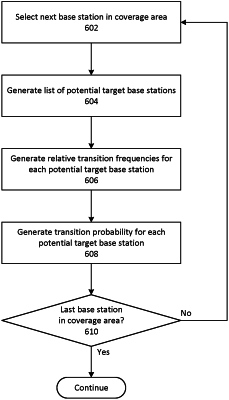| CPC H04W 68/005 (2013.01) [H04W 36/00835 (2018.08); H04W 36/08 (2013.01); H04W 36/32 (2013.01); H04W 60/04 (2013.01)] | 19 Claims |

|
1. A method of predicting a location of a user equipment, UE, in a mobile communication network having a plurality of base stations serving respective base station coverage areas, the method comprising:
for each base station in the mobile communication network:
generating a list of potential target base stations for the base station, the list of potential target base stations for the base station comprising base stations to which a transition from the base station occurs within a predetermined time period, wherein generating the list of potential target base stations comprises generating a transition count for each potential target base station, the transition count comprising a count of transitions from the base station to the potential target base station within the predetermined time period;
generating a plurality of relative transition frequencies based on the transition counts, each of the relative transition frequencies corresponding to one of the potential target base stations and describing a relative frequency of transitions from the base station to the corresponding potential target base station during the predetermined time period;
generating a transition probability for each respective potential target base station based on the relative transition frequency of the potential target base station from the base station;
comparing transition counts for each of the potential target base stations to a first threshold; and
in response to the transition count for one of the potential target base stations being less than the first threshold, removing the one of the potential target base stations from the list of potential target base stations for the base station.
|